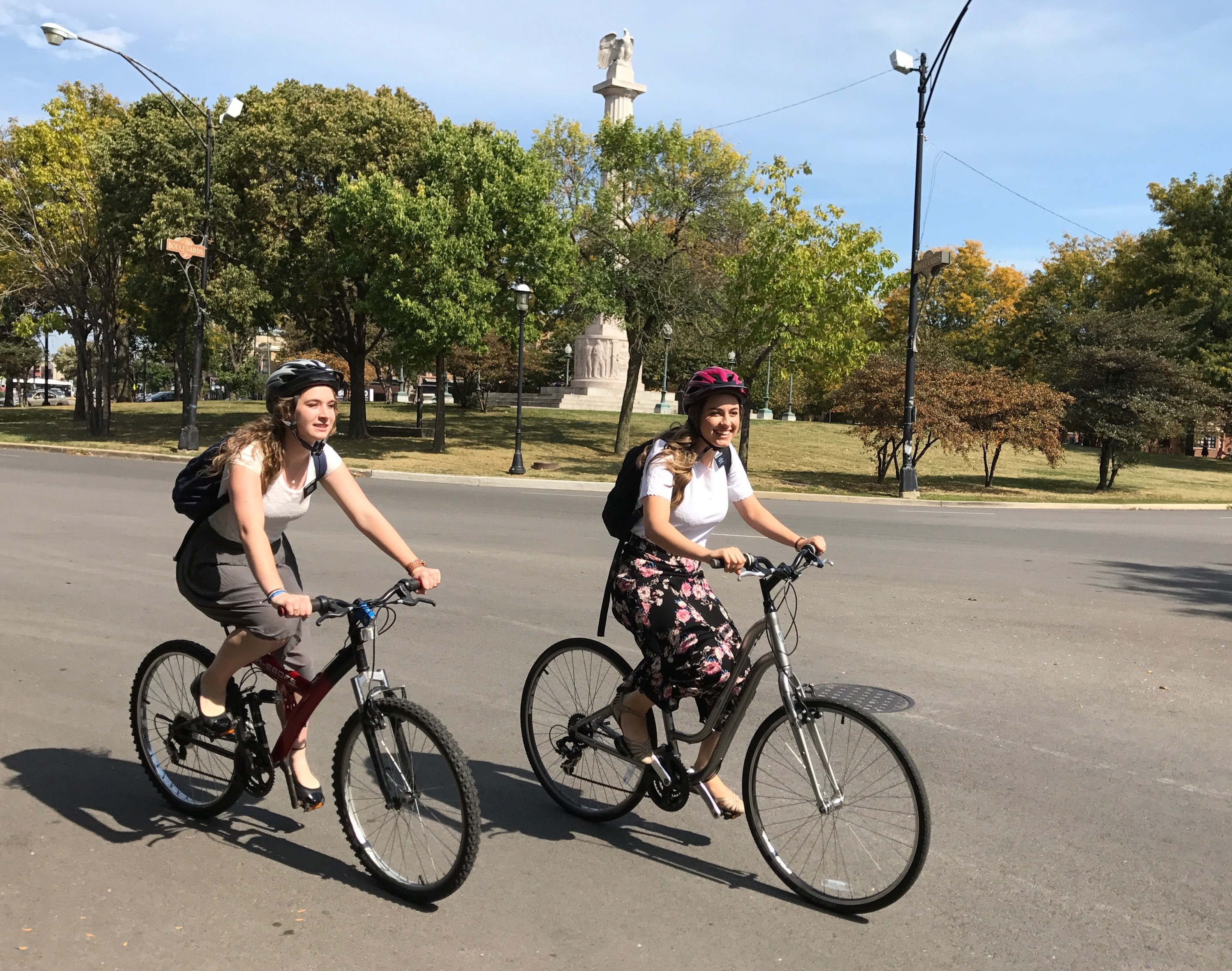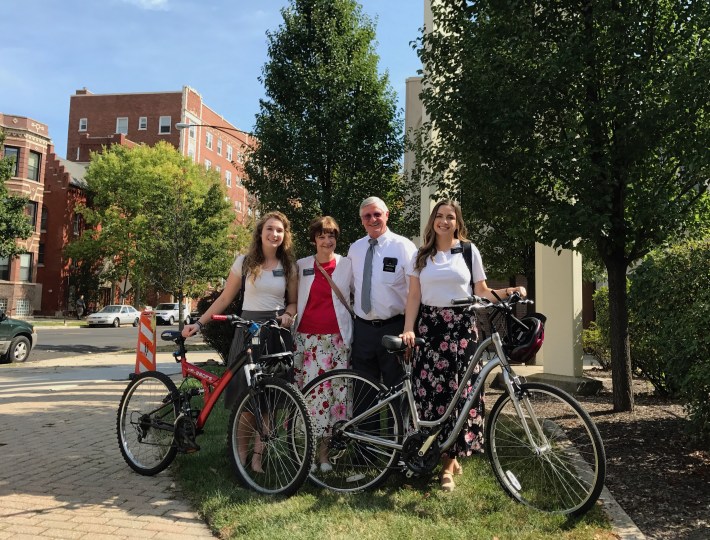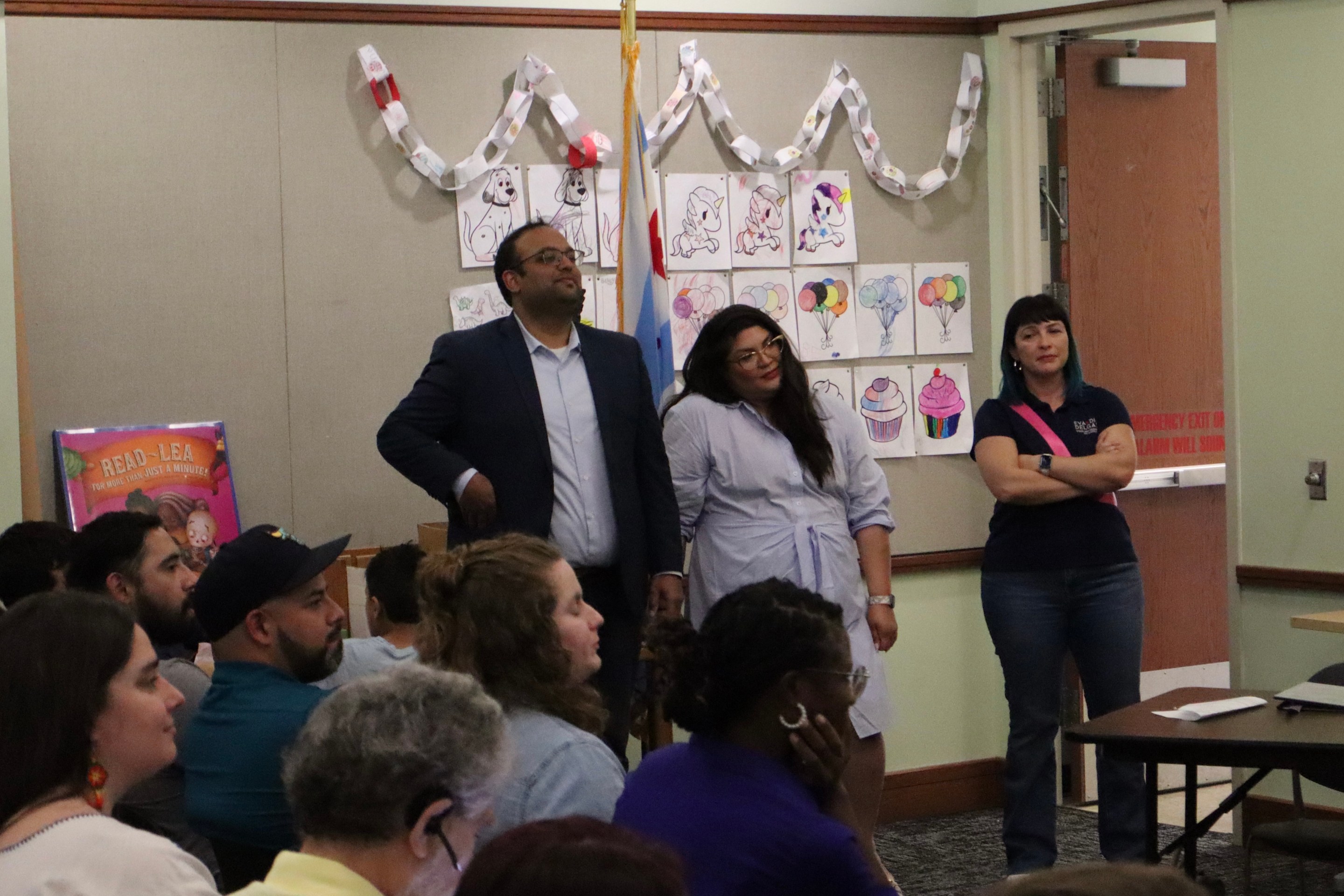Female LDS Missionaries Talk About Proselytizing on Pedals
12:55 PM CDT on September 29, 2017

Amanda Aamodt and Emily McCrary ride by Logn Square’s Illinois Centennial Monument. Photo: John Greenfield
[Streetsblog editor John Greenfield publishes a weekly transportation column in the Chicago Reader. We syndicate the column on Streetsblog Chicago after it comes out online.]
Some folks ride bicycles in Chicago for exercise, while others do it to reduce their carbon footprint. Amanda Aamodt and Emily McCrary pedal for a higher purpose; biking, they say, is the most affordable and efficient way to spread their Mormon faith to others around the city.
For decades it's been common to encounter young male missionaries—called "elders," ironically enough—dressed in white short-sleeved shirts and black slacks with neckties and name tags, navigating Chicago in pairs on cycles. Female missionaries (aka "sisters") on bikes is a more recent phenomenon.
"It's kind of a strange sight to see two clean-cut young women riding bikes in skirts in Chicago," says Aamodt and McCrary's supervisor, elder Mark Bingham. "It's very hard for them to be ladylike and modest—and yet they are. And they're undaunted by the summer rain and the traffic. . . . We know that they are protected by the hand of the Almighty in their valiant effort and are blessed as they make great personal sacrifice to declare the news of the restored gospel."
After connecting with Aamodt, McCrary, and Bingham through Alex Wilson, director of the youth education center West Town Bikes, who recently helped them out with some new rides and repairs, I caught up with them last week at Logan Square's Church of Jesus Christ of Latter-day Saints. The young women discussed the advantages of using bikes for their ministry, as well as the dangers and annoyances they face while pedaling through the city.
Bingham, 69, a farmer by trade, temporarily moved to Chicago in July with his wife, Sherry, a piano teacher, from Honeyville, Utah, near the Idaho border, after they were "called" by their faith to mentor young missionaries. "We love rubbing shoulders with these folks," he says. "It makes us feel young."
Aamodt, a 20-year-old from Pleasant Grove, Utah, south of Salt Lake City, has been on a mission in Chicago for 16 months. McCrary, 19, grew up in Rocklin, California, and came to Chicago about a month ago.
Nowadays men can go on a mission beginning at age 18, and their tour of duty lasts two years. Women must be at least 19, and their mission lasts 18 months. "We're dedicating that time 100 percent to serving God and sharing the message of the joy that He has brought into our lives with others," Aamodt says.
Worldwide there are 422 missions and more than 70,000 missionaries, according to LDS leadership. The Illinois Chicago Mission has at least 130 young missionaries and ten older mentors at any one time, with new ones coming in every six weeks. According to Bingham, about 18 to 25 people are baptized into the Mormon faith in the Chicago area each month due to outreach by missionaries.

Aamodt and McCrary cover a long, narrow stretch of territory bounded by Laramie, Belmont, Fullerton, and Lake Michigan, and they share an apartment in Hermosa. Like all Mormon missionaries, they're volunteers and are responsible for paying for their own living expenses. The two women were assigned to minister primarily to Latino residents within their district, although neither one previously spoke Spanish. After six weeks of language-immersion classes at the Missionary Training Center at Brigham Young University, extensive Bible study in Spanish, and frequent interactions with native speakers, they say they're now fluent.
Missionaries using bikes to make the rounds is a matter of pragmatism, Bingham says. "Sometimes Sherry and I follow them to appointments, and we have to park blocks away, but they can chain up right in front." Other benefits include avoiding traffic, and not having to pay for gas, parking, or tickets, which is crucial for young people on a fixed budget.
Another major perk is that biking exposes the missionaries to more residents and encourages spontaneous interactions with potential converts. "In a car you're kind of closed off, but on a bike you're out with the people," McCrary says.
Helmets are mandatory, and the missionaries get bike-safety training before they get rolling. Still, crashes aren't uncommon. During one particularly unlucky week, four members of the Illinois Chicago Mission were involved in separate collisions. The day before my interview with the sisters, a driver struck one of their fellow female missionaries in suburban Westchester, Bingham says. The young woman is OK, but her bike was totaled.
"We've had some crashes, but no tragedies," Bingham says. "I think the policy would be carefully studied if there was a tragedy. The biggest problem is the drivers: doors flying open and drivers who are turning and don't see bikes."
Aamodt says she's never worried about crash or crime dangers while traveling in Chicago. "I trust that we're on a mission from the Lord and as long as we're doing the things we should be doing, the Lord will protect us."
Bike use among sisters is still relatively uncommon, possibly due to supervisors being more protective of females. Wilson of West Town Bikes—who grew up in a Mormon family in Lincoln, Nebraska, but didn't go on mission and doesn't currently practice the religion—told me that in many districts women aren't allowed to use bikes for missionary work, and that supervisors cite safety as the main concern.
Bingham says he's especially mindful of keeping the young women safe on their bikes, even though he acknowledged that "the lady missionaries are very, very careful, the elders not so much." For example, when one of the women had a malfunctioning brake on her Schwinn three-speed, he insisted on taking it back to West Town to be fixed immediately. "In the case of the sisters, I wanted to make sure those bikes were right."
Despite the protectiveness of some mentors, Aamodt and McCrary believe the number of women using bikes is growing. Aamodt has female friends who are doing mission work on bikes in Florida, and she's also heard of cycling sisters in California and Japan.
One reason more female missionaries can be seen on bikes nowadays may be that the age requirement for women was lowered from 21 to 19 a few years ago. "So the increase in sisters on bikes probably reflects the overall increase in the number of female missionaries," McCrary says.
The mission maintains a fleet of used bikes missionaries can borrow, but many elders buy new ones when they get to Chicago. Lightweight, inexpensive fixed-gear single-speeds are currently popular with the male missionaries. "The elders are obsessed with their fixies," McCrary says. "They tease us that we should switch to fixed-gear."
Since it's less common for sisters to ride bikes, the ones who do tend to use the hand-me-downs, McCrary says. But the chain kept falling off the bicycle she was previously using, and its handlebars were covered with duct tape. "My dad's a big cyclist back home in California, so he thought it would be a good idea to get a safer bike." She now rides a silver Trek hybrid with a step-through frame.
The frame shape is important because sisters are generally required to wear skirts that cover the knees while working. "It allows the skirt to lay down around your legs while you bike," McCrary notes. "We try to always stay modest."
Despite their conservative dress, Aamodt and McCrary say they often experience sexual harassment when riding. "We get a lot of catcalling, a lot of inappropriate things being said," Aamodt says. "It can be discouraging, but we try to brush it off and remember why we're here."
Then there's the issue of "helmet hair," Aamodt says. "Every day we put on our helmets and look in the mirror and say, 'Well, we didn't come here to look like models, we came here to serve the Lord, so if that means wearing helmets, that's what we'll do.' "
In addition to editing Streetsblog Chicago, John writes about transportation and other topics for additional local publications. A Chicagoan since 1989, he enjoys exploring the city on foot, bike, bus, and 'L' train.
Stay in touch
Sign up for our free newsletter
More from Streetsblog Chicago
One agency to rule them all: Advocates are cautiously optimistic about proposed bill to combine the 4 Chicago area transit bureaus
The Active Transportation Alliance, Commuters Take Action, and Equiticity weigh in on the proposed legislation.
State legislators pushing to merge CTA, Pace, and Metra into one agency spoke at Transit Town Hall
State Sen. Ram Villivalam, (D-8th) and state Rep. Eva-Dina Delgado (D-3rd), as well as Graciela Guzmán, a Democratic senate nominee, addressed the crowd of transit advocates.



